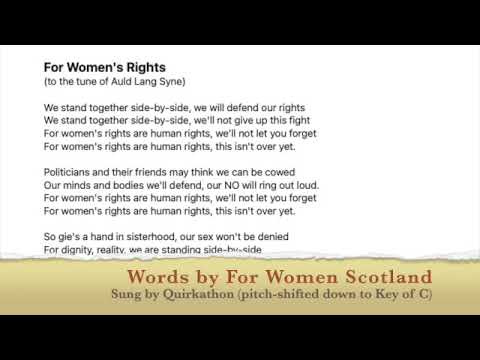Here we go with Day Two.
I voluntarily went into the overflow court room so that I could get a desk. This time I had my laptop with me so most of this update was typed during the hearing. The room was pretty full and had lots of excellent Terfs in it.
I provide extracts from today’s submissions as I did yesterday. All comments and queries gratefully received.
I provide a tentative conclusion at the end.
I appreciate how baffling all this, as my brother describes it, ‘legal b****cks’ can be.
Please read Day One first. Once again I am leaving out most of the case names. Please see Tribunal Tweets for further details.
Ruth Crawford KC for The Scottish Ministers (SM) [ Dusty, I am, of course, using her phraseology and her reasoning and likewise for the later counsel]
Is section 9(1) Gender Recognition Act (GRA) presumption disapplied by the Equality Act (EqA) - no express disapplication anywhere in the EqA. The correct question is where is the provision disapplying it not where is the provision applying it. Section 9(1) refers to ‘for all purposes’. No need, therefore, for an express application.
The purpose of the GRA is to make provision for change of gender. ‘Sex’ and ‘gender’ are used interchangeably - see s9(1).
Appellant says sex in EqA section 7 (gender reassignment) is natal sex. GRA does nor change meaning of sex including in the EqA. GRA provided what is to happen if you become a man or a woman. We say that sex in section 7 has nothing to do with proper construction of sex in the separate definition section.
There is no third sex - see various pieces of legislation including the GRA .
EqA protects people from discrimination re being a man or a woman. A person who becomes the other sex belongs to that sex and has the protections under the EqA even though not recorded as that sex at birth. A person who changes sex no longer belongs to their previous sex and no longer has the protections afforded to that previous sex in the EqA.
The revised Scottish guidance regarding gender recognition says nothing about living as a woman. If someone has declared intention to live as the opposite sex it would be strange if they could rely on provisions regarding their previous sex.
We will not discuss the sociological and historical background detailed by Mr O’Neill ( for FWS) since we will be addressing the consequences of a GRC being issued and this is the important question. The consequence of a GRC is not just some legal fiction but has far reaching consequences. It has effects re the situation between individuals and private organisations. It is a fundamental right.
Quoting from a case, she talks of the principle of statutory construction which can override the common law. The GRA recognises the legal effects of gender recognition. If one looks to Article 8 of the Human Rights Act (HRA - right to respect for private and family life), in other words it is a human right. We say GRC is not a legal fiction eg treating a child as the child of the adopter under law. Other areas (eg birth certificates) are effected by issue of a GRC.
Quoting another case, is surgery required? The aim of surgery is to make the individual more comfortable in his or her body but is not required re GRC. Parliament could have limited a GRC in this way but chose not to do so. If FWS are correct what are the consequences of people now covered by GRA - are they to remain in their natal sex until death?
Language is important - terms such as ‘certificated sex’ ought to be avoided. It is more accurate to talk of ‘the sex’ of a person whether that is their sex assigned at birth or as a result of the GRA. ‘Legal sex’ is found in secondary legislation. Sex Matters have provided figures of 8464 GRCs issued as at June this year. That is about 0.001% of the adult population. That small number goes some way to allay concerns re the Public Sector Equality Duty (PSED) on public sector organisations.
The GRA is Parliament’s response to recognition of a change.
Lesley Irvine, junior counsel, then took over for SM
The statutory purpose is to set out change of gender in light of violations of Article 8 found by European Court of Human Rights (ECtHR) in Goodwin v UK. Section 9(3) deals with exceptions and needs narrow construction since this is a fundamental right. We say only express intention to preclude s9(1) will actually preclude it. The court will not find such disapplication in the EqA.
She refers to Goodwin v UK. Legal recognition was not just for practical effect. The ECtHR refers to domestic law affecting an important part of personal identity. It is not a minor inconvenience - there are feelings of vulnerability and anxiety. The Court refers to unsatisfactory situation for transsexual individuals. The GRA was putting into effect legal recognition as an individual human being and thus fundamental rights.
The requirements for making a GRC need to be set out because this underlines the fact that this is a fundamental change in status and shows the onerous conditions required. GRA section 2 deals with determination of the application and there are 4 criteria:
has or has had gender dysphoria;
lived in acquired gender for 2 years ending with date of application;
intends to live in acquired gender until death;
complies with section 3.
Section 3 requires two medical reports and a diagnosis and two statutory declarations. A Panel has to make the final decision. If there is treatment, details have to be given but there does not actually have to be treatment.
Section 9 is under the heading ‘consequences of issue of GRC’. Section 9 is the cornerstone of the GRA.
Where a certificate issued, the person becomes the acquired gender. Section 9(1) sets down unqualified presumption which effects change in their legal status in terms of sex.
Sex and gender are interchangeable under s9(1). Sex in the GRA is not a reference to biological determinism. Goodwin v UK was a departure from the latter understanding of sex. Section 9 provides sex with the extended non-biological meaning.
Section 9(1) states what has occurred which is a change in legal status as to sex and is not a ‘deeming provision.’[ Dusty - A ‘deeming provision’ is a clause in a statute, regulation, or other legal instrument that treats a situation as existing when it does not. Deeming provisions are also known as "legal fictions"].Sex Matters says s9(1) is a weak deeming provision which can be displaced. Amnesty also refer to it as a deeming provision.
We think it is doubtful it can be called a deeming provision and the approach to be followed is set out in section 9 as a whole. The outcome of the statutory construction exercise may not make much practical difference whether it is a deeming provision or not. There is no support for saying it is a weak presumption if you look at the words actually used.
Section 9(2) provides that s9(1) does not relate to things done before the GRC was issued. The effect of s9(2) is to provide that sex based references from the issue of the GRC require to be read in light of the presumption that the gender and sex has been changed. Section 9(2) gives far reaching affect to the statutory purpose of the GRA and thus applies to other statutes.
Section 9(3) provides that s9(1) is subject to a provision made by any other enactment. That is a qualification to s9(1). Section 9(3) does not affect how s9(1) applies and s9(1) is thus not diluted since it is ‘for all purposes’. Section 9(1) could be disapplied ( but on a question from Lady Simler, Ms Irvine was unable to quote a future act which directly disapplied it). Section 9(3) needs to be narrowly construed because otherwise the core statutory purpose of the GRA will be undermined.
What type of intention is required? Only express intention to disapply s9(1) will disapply it. She refers to a HRA case that says that Parliament can legislate against principles of human rights but this must be completely clear because these are fundamental rights. In section 9(1) Parliament has legislated re a fundamental right as to identity. If Parliament wishes to depart from s9(1) it requires to squarely confront what it is doing and accept the political cost. Parliament has not made any such unambiguous provision.
Section 9(3) applies to later legislation because s9(1) sets down a legal presumption which prior to the GRA was not possible. Section 9(2) looks backward as well as forwards. Section 9(3) is essentially how the presumption is disapplied by clear intention but does not apply to any relevant legislation prior to the GRA.
As an example, section 12 of the GRA is clear about disapplication of s9(1) regarding reference to mother or father of a child not changing. There is no such provision in the EqA.
Ruth Crawford then resumed the case for the SM.
It is clear that Parliament had the GRA in mind when enacting the EqA. Four factors:
Schedule 6 of the GRA was repealed which dealt with the Sex Discrimination Act where s9(1) had effect;
Section 19 of the GRA was repealed - the ‘sporting’ provision. The EqA introduced similar though not identical provision. Re sport (EqA s195), it is said by Sex Matters that s195 of EqA only applies to competitive sport. Gender effected activity encompasses most activities where strength and the like gives rise to disadvantages. Section 195 does not disapply s9(1) but those with a GRC may not be able to compete with others of ‘that sex’ because they also have the factor of gender reassignment;
There were no other repeals of the GRA in the EqA;
No mention of solemnisation of marriages - Part 6 of EqA - we see an express disapplication of section 29 prohibition on provision of services and express acknowledgement of the presumption in GRA s9. The disapplication is where a person who can refuse to carry out a marriage regarding a person with a GRC ( this point strongly challenged by the judges).
The GRA, it is said, runs contrary to the purpose of the EqA. We disagree. It ensures that those who have a GRC are entitled to protections given to that sex in the EqA. Sex Matters said that the purpose of EqA was to deal with unfavourable treatment of individuals and also group disadvantage. If confined to natal sex it will include natal women who do not have a GRC and natal women who have a GRC and some of these may have undergone gender reassignment surgery.
An argument is also made against us re Sex Discrimination Act (SDA) [ Dusty - this is the Sex Discrimination Act 1975 which was repealed by the EqA] which excluded gender reassignment. The amendments to SDA were made in response to a case called P v S and did no more than required by the decision. P v S was followed later in time by Goodwin v UK. After the GRA was passed, there was no need to expand the definition of sex in the SDA.
For Women Scotland (FWS) say that the concept of ‘perception discrimination’ under the EqA s13 may include a natal man who has changed to presenting as a woman. We say that a natal man with a GRC does not have to rely on ‘perception.’ If relying on ‘perception’ you may be guilty of stereotyping.
She went on to some of the ‘problems’ that have been raised by FWS.
With regard to sexual orientation under the EqA. When a person becomes the sex of their acquired gender that changes the class of persons to whom the person is orientated towards. That does not affect the ability of that person to invoke direct discrimination provisions re sexual orientation. A woman whose sex is recorded at birth and is orientated to other women becomes no less attracted to those women but may not be attracted to women in that class who have GRCs [ enormous laughter in court room two at this stage].
With regard to associations, under EqA an association does not discriminate if they restrict membership to people of a protected characteristic. So a lesbian group could not exclude a natal male with a GRC - she suggests they could rely on ‘philosophical belief’ [ more enormous laughter].
Lady Simler talked of the ‘chilling effect’ on such groups. You can’t ask if someone has a GRC!
Ms Crawford claimed there was no chilling effect!
Lady Simler came back to the chilling effect.
Ms Crawford insisted it would not occur. She suggested it related to freedom of thought, expression and assembly.
Lord Reed said they needed an interpretation that was workable in practice. How can the association tell whether the natal male has a GRC or not.
Lady Rose talked of the question of single sex health provisions.
Ms Crawford then referred to the pregnancy and maternity provisions in the EqA. Firstly she questions how these provisions can influence the question of statutory construction. This refers to a natal female with a GRC who becomes pregnant - our position is that these consequences do not require to be taken into account but, if the court thinks they do, we suggest two solutions:
a) Any difficulties arising from exclusion of natal female with a GRC are to be resolved by Parliament;
b) These provisions be applied to those who are pregnant as a matter of fact regardless of the provisions relating to the GRC because ‘woman’ is not the essential element but the fact of pregnancy.
Lord Reed pointed out that some provisions relate to sex not just pregnancy. Cervical cancer just affects natal women. The law around pregnancy all relates to women. All intricately linked.
Ms Crawford says this court could decide, if they disagreed with her, that s9(1) is disapplied because of these problems.
Jason Coppell KC then spoke for the Equality and Human Rights Commission (EHRC).
EHRC agrees with SM that the effect of s9(1) means sex in the EqA should accord with the sex recorded under any GRC. The EHRC also agrees that this creates anomalies and difficulties in the practical application of the EqA. They highlight matters that were either not properly addressed or have arisen subsequently and show that Parliament needs to reconsider the EqA.
The SDA [ 1975] is a significant factor as to why we say Parliament intended s9(1) to apply to EqA. A legal sex interpretation ( post surgery) in A v A Chief Constable was relied on due to European Union provisions. GRA brought in GRCs. The Government intended to change the meaning of the SDA and we say that was the effect of the GRA. We submit that the Inner House in this matter held s9(3) refers to the GRA and future enactments and not previous enactments such as the SDA. Section 9(1) is meant to apply ‘for all purposes’. Otherwise s9(1) would be weakened.
Provision disapplying s9(1) re the SDA could have been made in the GRA itself.
Therefore FWS would need to show that the EqA intended to change this effect on the SDA. There is no indication in any of the pre-legislative materials that it was intended to disapply s9(1). The EqA makes express amendments to the GRA and thus there was an opportunity to make it clear. The provisions in EqA are all virtually the same as in the SDA. FWS assume that female is to be given a biological meaning.
FWS ask the court to find some clear provision and Sex Matters say what would be the better interpretation. These are incorrect. We say that there must be an explicit disapplication of s9(1).
The court should not weigh up policy aspects of competing views. There was a purpose for allowing a ‘transperson’ to get a GRC. There are complications if they cannot claim under their certificated sex eg. equal pay claims.
There are other provisions of the SDA that assist. Section 29 re goods and services has exceptions including in section 35 for single sex services. We say they would lead to a difficult situation re ‘transpersons’.
Human rights issues - we urge the court to reject the invitation by the interveners to make findings that their interpretation complies with European Convention rights. Is there any gap in terms of human rights by the protection afforded by the EqA? The Court is not in a position to decide this without real facts and detailed facts before them.
On questioning by Lady Simler, Mr Coppell accepted that the EHRC had not identified any actual gaps.
Mr Coppell said there is no ECtHR case law to support breach of convention rights in these circumstances.
When passing the EqA, Parliament did not think through the SDA definition of man and woman. No evidence of consideration of so called ‘pregnant men’ etc
Mr Coppell says that society has evolved since GRA and EqA. The position today is that there are much larger numbers of trans people who do not have a GRC and do not intend to get one. EHRC accepts some need to move to a biological sex meaning.
Pregnancy protections fail to cover ‘transmen’ who are pregnant. Some of them could claim under gender reassignment.
Freedom of association for women - a heterosexual trans woman with a GRC becomes a same sex attracted woman and that has a significant impact for women. It is not likely to be lawful for a woman only association to exclude someone who is a transwoman with a GRC. We agree that there is a chilling effect on women’s associations.
On single sex services, we are not aware of a person being refused NHS treatment on account of their natal sex. Lady Rose said what if a man with a GRC wanted to access cervical screening or such services?
Aidan O’Neill KC responded on behalf of FWS.
1999 regulations were simply to comply with decision in P v S ( an unfair dismissal claim) and are predicated on the biological notion of sex. Sex could not change in 1999. The 1999 regulations are based on sex being biological sex so when they talk about the gender reassignment provision it is still in a biological sense. It remains the case that GRA is concerned with relations with the State. EHRC says that the Court mangled it and Parliament will have to deal with it. We need this Court to put the intention of Parliament into effect.
He rejects the comparison with adoption since adoption is a private and family law matter.
If section 9(3) has to have express provision to work that empties s9(3) of any meaning.
In relation to Goodwin v UK, this case only deals with the post-operative transsexual. There is no decision to the effect that a man wanting to be a woman should be treated as such.
Why do the hurt feelings of natal men trump the rights of women? Gender identity and gender reassignment are not higher rights. The SM approach ignores women’s rights. Women’s fundamental rights cannot be overriden by unclear words. Women’s rights are human rights.
Dusty’s tentative conclusions
Ms Crawford for the Scottish Ministers got in a right mess when trying to discuss the anomalies that arise from treating a, let’s say, natal male with a GRC as a female for the purposes of the Equality Act ( see above for the details). At this stage you could have mistaken the overflow court room for a comedy club - people were roaring with laughter. She ended up seeming to concede that, if the Court felt that these anomalies were impossible to deal with, they might disapply the GRA ie. sex in the Equality Act would be biological sex. This is major.
I thought that the EHRC’s arguments that the Sex Discrimination Act had already made adjustments for gender reassignment and that the Equality Act did not say it was changing that approach, was more difficult to deal with ( albeit I think For Women Scotland and Sex Matters did answer those points very well).
The Scottish Ministers kept on stressing that they thought that the GRA created a fundamental right but, if so, why was there a specific provision ( section 9(3)) as to it being potentially disapplied by a future statute.
I would never like to predict a case but I felt much more positive by the end of day two. Sex Matters seem to think that we might not get a judgment until next April! Certainly the Supreme Court always take a long time to hand down a judgment.
#BeMorePorcupine
#LetWomenSpeak
#Grassroots Army
#GenderIdeologyIsEvil
#VoteAontú
#Woman:AdultHumanFemale
#ForWomenScotland








Oh lord, Dusty, how on earth did you stay awake? That we’ve come to this: legal wrangling about the Gender Reassignment Act V the Equality Act? I felt like Alice in wonderland & was tempted to shout at their honours, “off with their heads” about the Scottish minister’s ridiculous attempt to get Self-ID in law. Thanks for your marathon efforts to bring this insanity to us. Will share.
I found this comment very interesting - "If someone has declared intention to live as the opposite sex it would be strange if they could rely on provisions regarding their previous sex."
I have already heard of a situation, in the USA, where a woman with endometriosis wasn't covered by her medical insurance for treatment, because the women 'identifies' as a man. I daresay that this is wider spread than just the one situation I've read about. My feelings about whether or not I feel sorry for such women are mixed, and the same would apply to men who say they're women, although, because these men cause a whole heap more problems for women with their cross-dressing fetish, I lean more towards the 'not'.